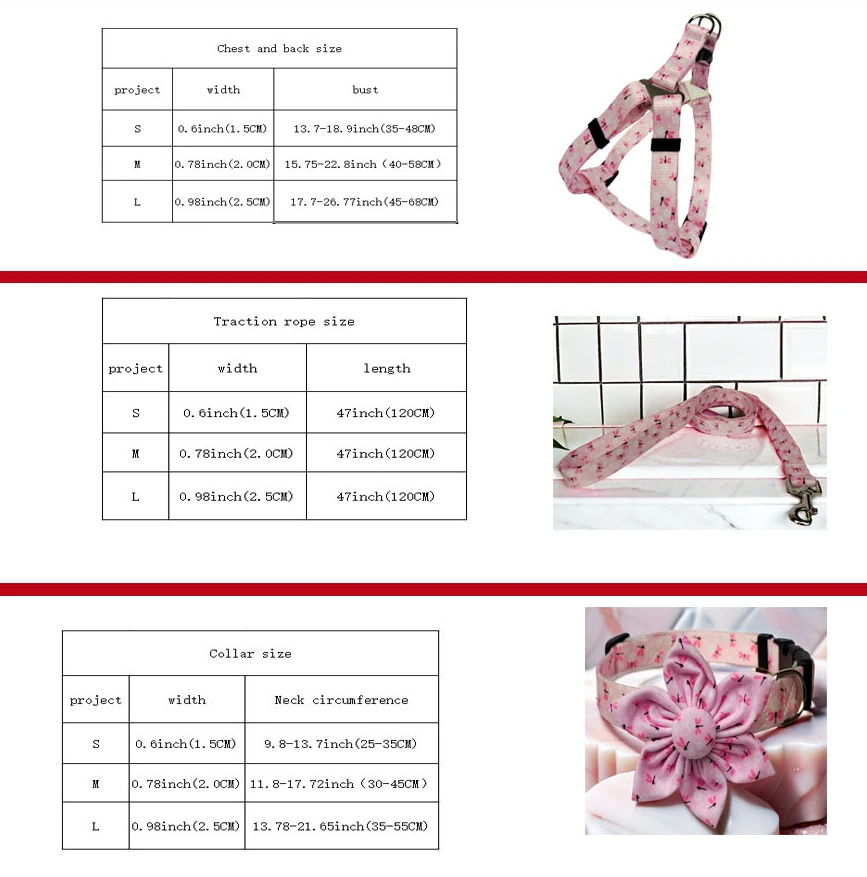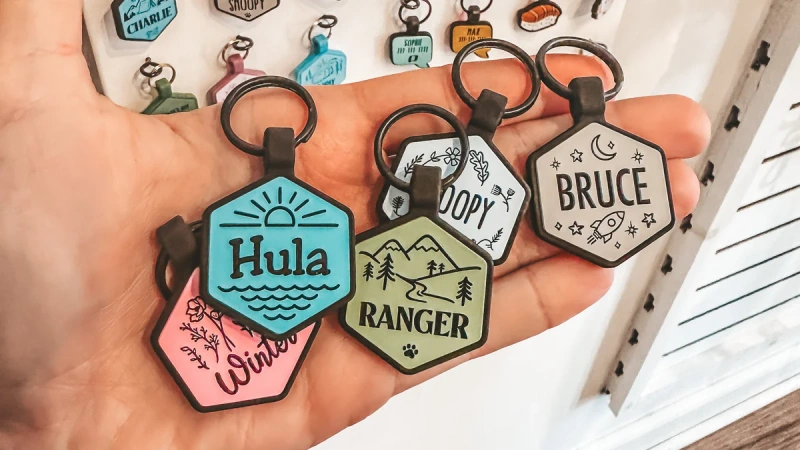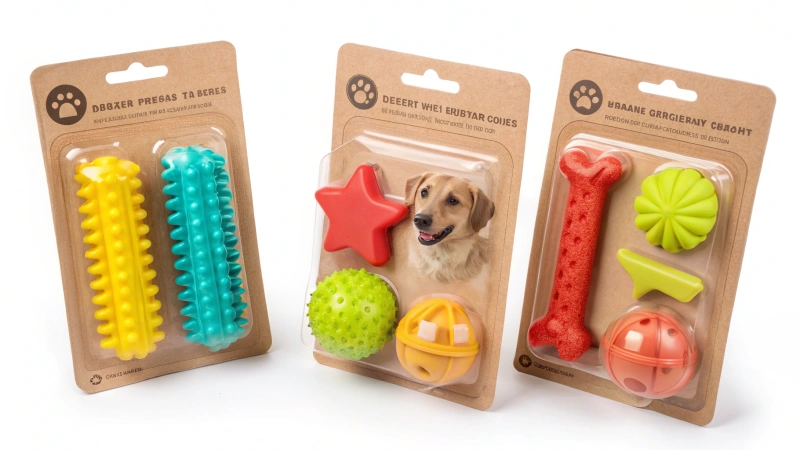Are you struggling to find the right fit for your dog’s collar, leash, or harness? You’re not alone! Many dog owners face this challenge, but don’t worry – we’ve got you covered. This guide will walk you through everything you need to know to measure your furry friend correctly. Let’s make sure your pup is comfortable, safe, and stylish on your next walk!
For those in a hurry, here’s a quick rundown:
- Collar: Measure neck circumference and add 2 inches for comfort
- Leash: A standard 6-foot length works for most dogs
- Harness: Measure chest girth, neck circumference, and length from chest to base of tail
Now, let’s dive into the details!
Introduction
Picture this: You’re excited about your new dog collar, but when you put it on your pup, it’s either too tight or so loose it might slip off. Frustrating, right? Well, you’re about to become an expert in getting the perfect fit!
Why does a proper fit matter so much? It’s simple:
- Comfort: A well-fitted collar, leash, or harness means your dog can enjoy walks without discomfort.
- Safety: The right fit prevents injuries and ensures your dog can’t slip out during walks.
- Effectiveness: Proper fit makes training easier and more effective.
In fact, according to a survey by the American Pet Products Association, 83% of dog owners use collars, while 56% use harnesses. With so many of us using these products, getting the fit right is crucial!
Essential tools for measuring

Before we start, let’s make sure you have the right tools:
- Flexible tape measure: This is your best friend for getting accurate measurements. It can easily wrap around your dog’s body for precise numbers.
- String and ruler: Don’t have a tape measure? No problem! Use a piece of string to wrap around your dog, mark the length, and then measure the string with a ruler.
- Treats: These are your secret weapon. A few treats can keep your dog still and happy during the measuring process.
Pro tip: If your dog is wiggly, try measuring when they’re tired after a walk or play session.
How to measure for a dog collar
Now, let’s tackle the collar first. Follow these steps:
- Get your dog to stand up straight. It might help to have a friend hold a treat in front of them.
- Take your tape measure (or string) and wrap it around your dog’s neck where the collar would sit. This is usually just below the jawline and above the shoulders.
- Make sure you can slip two fingers between the tape and your dog’s neck. This is the “two-finger rule” – it ensures the collar won’t be too tight.
- Note down this measurement. Let’s say it’s 14 inches.
- Add 2 inches to this measurement for comfort. So in our example, the ideal collar size would be 16 inches.
Remember, accuracy is key! Measure at least twice to make sure you’ve got it right.
Choosing the right size
Most collars come in size ranges. Using our 16-inch example:
- If you see a collar sized 14-16 inches, that’s perfect!
- If the sizes are 12-14 inches and 16-18 inches, go for the larger one (16-18 inches).
Choosing the right leash length
Good news – leash fitting is much simpler! Here’s what you need to know:
Standard length: A 6-foot leash is the go-to for most dogs and situations. It gives your dog some freedom to explore while keeping them under control.
But wait, there’s more to consider:
- Dog size: Smaller dogs might do well with a 4-foot leash, while larger breeds might need up to 8 feet.
- Behavior: If your dog tends to pull, a shorter leash (4-5 feet) can help with training.
- Environment: In busy urban areas, a shorter leash offers more control. For hikes or open spaces, a longer leash (up to 30 feet) can be great for exploration.
Did you know? A study in the Journal of Veterinary Behavior found that longer leashes (5m/16ft) resulted in less pulling behavior compared to shorter leashes (1.5m/5ft). However, always prioritize safety and follow local leash laws!
Measuring for a perfect harness fit
Harnesses can be tricky, but we’ll break it down for you:
Step 1: Chest girth
- Have your dog stand up straight.
- Wrap the tape measure around the widest part of their chest, usually right behind the front legs.
- Note this measurement. Let’s say it’s 25 inches.
Step 2: Neck circumference
- Measure around the base of the neck, where it meets the shoulders.
- This might be slightly larger than your collar measurement.
- Let’s say this is 16 inches.
Step 3: Length (for full-body harnesses)
- Measure from the base of the neck to the base of the tail, along the spine.
- This might be around 20 inches for a medium-sized dog.
Pro tip: If your dog has thick fur, gently compress it as you measure to get an accurate size for when the harness is on.
Remember, different harness styles might need slightly different measurements. Always check the manufacturer’s sizing guide!
Special considerations
Every dog is unique, and sometimes you need to think beyond the basic measurements. Let’s look at some special cases:
Puppies and growing dogs
If you’ve got a puppy, you’re in for a fun ride! Puppies grow fast, sometimes gaining 2-4 pounds a week. This means you’ll need to measure often:
- Measure every 2-4 weeks for the first 6 months
- After 6 months, measure monthly until they’re fully grown
Pro tip: Look for adjustable collars and harnesses. These can “grow” with your pup, saving you money and hassle.
Breed-specific tips
Some dogs have unique body shapes that require special attention:
- Bulldogs and Pugs: Their broad chests and short necks mean they often need harnesses designed for “barrel-chested” breeds.
- Greyhounds and Whippets: These slender pups have narrow heads. Look for martingale collars or harnesses that won’t slip off.
- Dachshunds: Their long bodies need harnesses that distribute pressure evenly to protect their backs.
Adjusting for thick fur or weight fluctuations
- For fluffy friends like Huskies or Chow Chows, measure when their coat is at its fullest. Compress the fur gently as you measure.
- If your dog’s weight tends to fluctuate (like some Labs or Beagles), choose adjustable gear and re-measure seasonally.
Common measurement mistakes to avoid
Let’s steer clear of these common pitfalls:
- Measuring too tightly: This is the number one mistake! A too-tight collar or harness can cause discomfort, chafing, or even breathing issues. Always use the two-finger rule.
- Not accounting for growth: Remember that 8-week-old Lab puppy? In just 4 months, they could grow from 10 pounds to 40 pounds! Always factor in room for growth when buying gear for puppies.
- Ignoring breed-specific needs: A harness perfect for a Beagle might be all wrong for a Greyhound. Research your breed’s specific needs or ask your vet for advice.
- Assuming one size fits all brands: A “Medium” in one brand might be a “Large” in another. Always check the specific measurements for each product.
- Measuring when your dog is distracted: An excited or nervous dog might tense up, giving you inaccurate measurements. Try measuring when they’re calm and relaxed.
How to use your measurements when shopping
Now that you’ve got your measurements, let’s put them to use:
Understanding size charts

Each brand usually has its own size chart. Here’s how to use them:
- Find your measurement on the chart
- Look at the corresponding size
- If you’re between sizes, usually size up
For example, if your dog’s neck measures 16 inches:
- Brand A’s chart: Small (14-16″), Medium (16-18″) → Choose Medium
- Brand B’s chart: Medium (15-17″), Large (17-19″) → Choose Medium
Converting measurements to size ranges
Some charts use ranges instead of exact measurements. Here’s a general guide:
- Extra small: Under 10″
- Small: 10-14″
- Medium: 14-18″
- Large: 18-24″
- Extra large: Over 24″
Remember, these are just guidelines. Always check the specific brand’s chart!
When to size up or down
- Size up: If your dog is between sizes, growing, has thick fur, or if you’re buying a winter coat.
- Size down: Rarely, but sometimes for very precise training tools or if the brand runs large.
Conclusion
Congratulations! You’re now a pro at measuring your dog for the perfect fit. Let’s recap the key points:
- Always use the right tools: a flexible tape measure or string and ruler
- Measure multiple times for accuracy
- Use the two-finger rule for comfort
- Consider your dog’s breed, age, and unique body shape
- Check brand-specific size charts when shopping
Remember, a well-fitted collar, leash, or harness isn’t just about comfort – it’s about your dog’s safety and your peace of mind. By taking the time to measure correctly, you’re ensuring happier walks, more effective training, and a stronger bond with your furry friend.
Don’t forget to re-measure your dog regularly, especially if they’re still growing or if their weight fluctuates. A good rule of thumb is to check the fit every 3-6 months for adult dogs, and more frequently for puppies.
FAQ section
Q: How often should I measure my dog?
A: For puppies, measure every 2-4 weeks until 6 months old, then monthly until fully grown. For adult dogs, every 3-6 months is usually sufficient.
Q: What if my dog falls between sizes?
A: Generally, it’s better to size up and adjust as needed. A slightly loose collar or harness is safer than one that’s too tight.
Q: Can I use the same measurements for all brands?
A: No, sizes can vary between brands. Always check the specific size chart for each product you’re considering.
Q: My dog hates being measured. Any tips?
A: Try measuring when they’re tired after a walk. Use treats to create positive associations, and keep measuring sessions short and fun.
Q: Are there any signs that my dog’s collar or harness doesn’t fit properly?
A: Watch for signs like excessive panting, chafing, hair loss around the collar area, or your dog trying to paw at their collar or harness.
Remember, the perfect fit means a happier, safer dog. Happy measuring, and enjoy those walks with your perfectly fitted pup!






